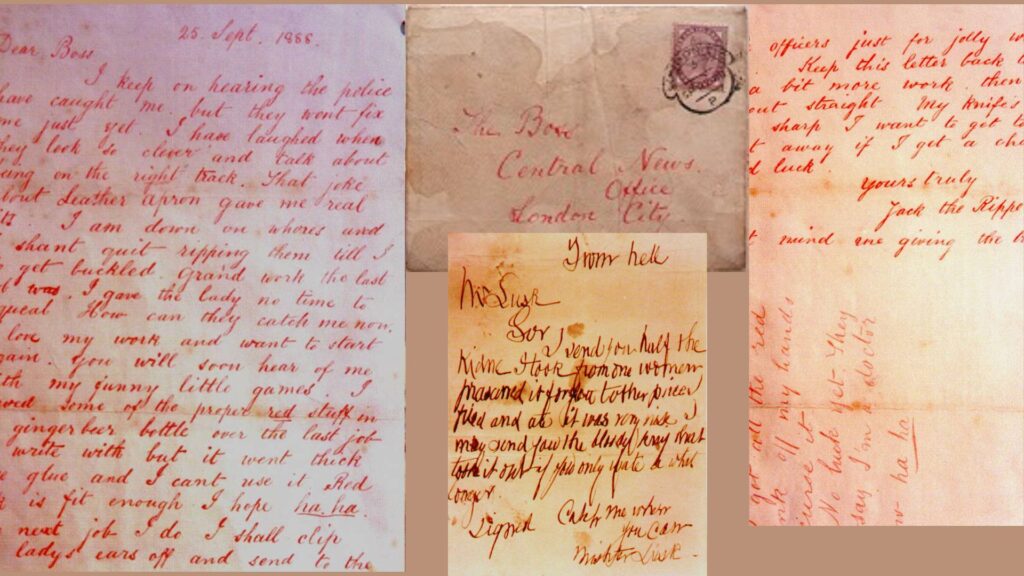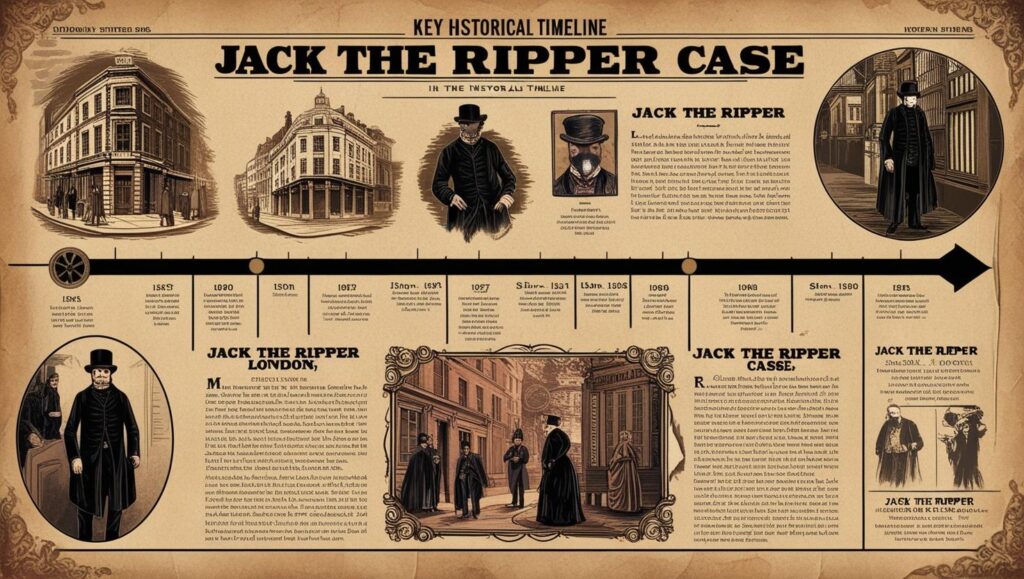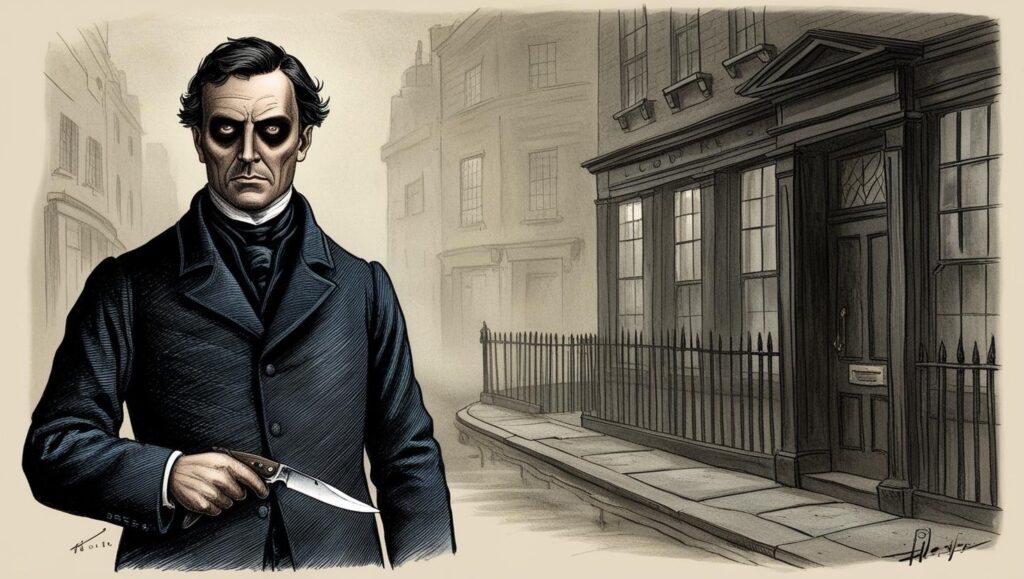A Killer in the Mist
In the heart of Victorian London, during the foggy autumn of 1888, fear crept through the narrow alleys of Whitechapel. A mysterious figure stalked the streets, striking in the dark of night, leaving behind mutilated bodies and unanswered questions. This was no ordinary killer—this was Jack the Ripper.
Over 130 years later, the mystery of Jack the Ripper continues to captivate historians, true crime enthusiasts, and the curious. But what made this case so chilling, and why does it still haunt the collective memory of society? This is the story, told through the timeline of terror, of one of the most infamous unsolved serial murder cases in history.
London in 1888: A City Divided
The East End of London, particularly the Whitechapel district, was plagued with poverty, crime, and overcrowding. Streets were dimly lit, sanitation was poor, and many women resorted to prostitution to survive. Into this chaos stepped a killer who would come to symbolize the darkest capabilities of man.
The police, still developing modern investigative methods, struggled to maintain control as fear spread. The media, thriving in the age of sensationalism, helped immortalize the Ripper’s legend.
Timeline of the Canonical Five: A Trail of Blood
1. Mary Ann Nichols – August 31, 1888
At around 3:40 a.m., the body of Mary Ann Nichols, 43, was found in Buck’s Row (now Durward Street). Her throat had been slashed twice, and her lower abdomen was mutilated with deep incisions. Her death marked the beginning of the known Ripper attacks.
2. Annie Chapman – September 8, 1888
Annie Chapman’s body was discovered at 29 Hanbury Street. Her throat was cut deeply, and her abdomen had been brutally opened, with her uterus removed. This killing showed increased ferocity and precision, suggesting the killer had anatomical knowledge.
3. Elizabeth Stride – September 30, 1888
At around 1:00 a.m., Stride was found in Dutfield’s Yard off Berner Street with her throat cut. Unlike the other victims, there were no abdominal mutilations. Investigators believed the killer might have been interrupted before he could complete his ritual.
4. Catherine Eddowes – September 30, 1888
Less than an hour after Stride’s body was found, police discovered Eddowes in Mitre Square. Her face was mutilated, her abdomen opened, and one kidney and part of her uterus were missing. The proximity in time and distance suggested the same killer.
5. Mary Jane Kelly – November 9, 1888
The most gruesome murder, Kelly was found in her rented room at 13 Miller’s Court. Her body was nearly unrecognizable—face hacked beyond recognition, abdominal organs removed and placed around the room, and her heart missing. This final murder was considered a crescendo of horror.
Letters from the Killer? The Ripper’s Mockery

Throughout the killing spree, various letters were sent to the police and local press, allegedly from the murderer.
- “Dear Boss” Letter (September 25): This note coined the name “Jack the Ripper.” It threatened further killings and taunted the authorities.
- “Saucy Jacky” Postcard (October 1): Brief and brash, this postcard referenced the double murder of Stride and Eddowes.
- “From Hell” Letter (October 16): Sent to George Lusk of the Whitechapel Vigilance Committee, it was accompanied by a box containing half a human kidney, allegedly from Eddowes.
Though many letters were dismissed as hoaxes, some still believe one or more may have been genuine communications from the killer.
Suspects and Theories: Who Was Jack the Ripper?

Despite countless investigations, Jack the Ripper’s identity remains unknown. Here are a few of the most discussed suspects:
- Aaron Kosminski: A Polish immigrant and barber who was institutionalized in an asylum. Modern DNA analysis from a shawl (claimed to belong to Eddowes) suggests a connection, though critics question the evidence’s validity.
- Montague John Druitt: A barrister who committed suicide shortly after Kelly’s murder. Some believe mental illness and his sudden death link him to the killings.
- Walter Sickert: A painter obsessed with the murders. Author Patricia Cornwell accused him using modern forensic and psychological profiling, though her theory is widely disputed.
- Jill the Ripper: Some have speculated the killer may have been a woman, possibly a midwife, which could explain the anatomical knowledge and ability to move unnoticed.
No theory has been conclusively proven, leaving the case open to speculation and intrigue.
The Aftermath: A City Forever Changed
The Jack the Ripper case transformed criminal investigation, journalism, and public awareness of violence against women. It led to improvements in forensic science, policing, and the treatment of marginalized communities, though those changes came slowly.
The case also marks the intersection of crime and media. Newspapers sensationalized the murders, spreading public panic but also keeping pressure on law enforcement to act. The identity of Jack the Ripper became a myth, a ghost that still haunts pop culture today.
Legacy in Popular Culture
Jack the Ripper has been portrayed in films, books, music, and video games. He appears as a symbol of evil in countless fictional retellings, often with creative liberties:
- From Hell (2001): A film starring Johnny Depp, based on the graphic novel by Alan Moore.
- Ripper Street (2012–2016): A BBC series following the aftermath of the murders.
- Assassin’s Creed Syndicate: Jack the Ripper DLC: A video game expansion that lets players hunt the killer.
These portrayals have ensured the Ripper’s myth endures far beyond the streets of Whitechapel.
Conclusion: The Riddle in the Fog
Jack the Ripper was more than a killer—he was a phenomenon. His reign of terror was brief, but the ripples he caused in law enforcement, media, and society continue to spread. In many ways, he was the first modern serial killer, both in method and myth.
As we revisit the foggy streets of 1888, the whispers of Jack the Ripper remind us that some shadows refuse to fade. The unanswered questions, the chilling brutality, and the silent figure who vanished into the night ensure that his legend will remain an unsolved puzzle for generations to come.
“Enjoyed this true crime story? Subscribe to our newsletter for more historical mysteries, forensic breakthroughs, and legendary criminal cases brought to life.”


